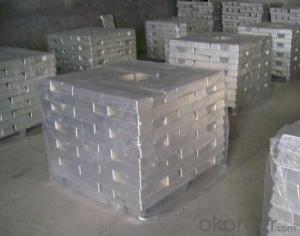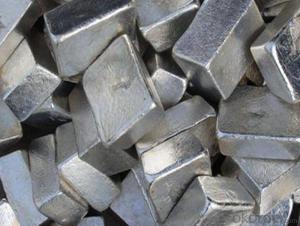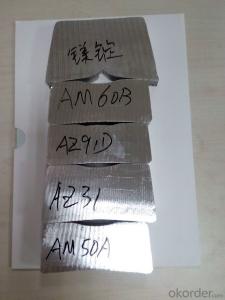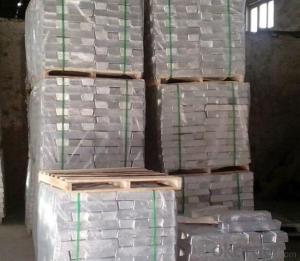Magnesium Alloy Ingot Seller Good Quality Magnesium Metal Ingot
- Loading Port:
- Tianjin
- Payment Terms:
- TT OR LC
- Min Order Qty:
- 1 m.t.
- Supply Capability:
- 100000 m.t./month
OKorder Service Pledge
OKorder Financial Service
You Might Also Like
Specification
Magnesium Alloy Ingot Seller Good Quality Magnesium Metal Ingot
1. Specification:The Mg Metal is a fairly strong, silvery-white, light-weight metal.
Form: ingot
ingot: (8 ± 0.5) kg / ingot
Specifications: (50-55)cm×(11.5-13.5)cm×(7-7.5)cm
2. Application:
1. The high temperature at which magnesium burns makes it a useful tool for starting emergency fires during outdoor recreation. Other related uses include flashlight photography, flares, pyrotechnics and fireworks sparklers.
2. To photoengrave plates in the printing industry.
3. In the form of turnings or ribbons, to prepare Grignard reagents, which are useful in organic synthesis.
4. As an additive agent in conventional propellants and the production of nodular graphite in cast iron.
5. As a reducing agent for the production of uranium and other metals from their salts.
6. As a sacrificial (galvanic) anode to protect underground tanks, pipelines, buried structures, and water heaters.
3. Mg Alloys Metal (Ingot)

4. Advantages:
Good Quality ............... The most important factor we care.
Competitive Price ........ For our mutual benefit.
Prompt delivery ........... Abundant production ability, storage ability and manpower.
Excellent Service ......... Customer always first.
Now our main markets in Asia and Europe, to the future we will set up sales network in more than 200 countries around the world.
5. Image:
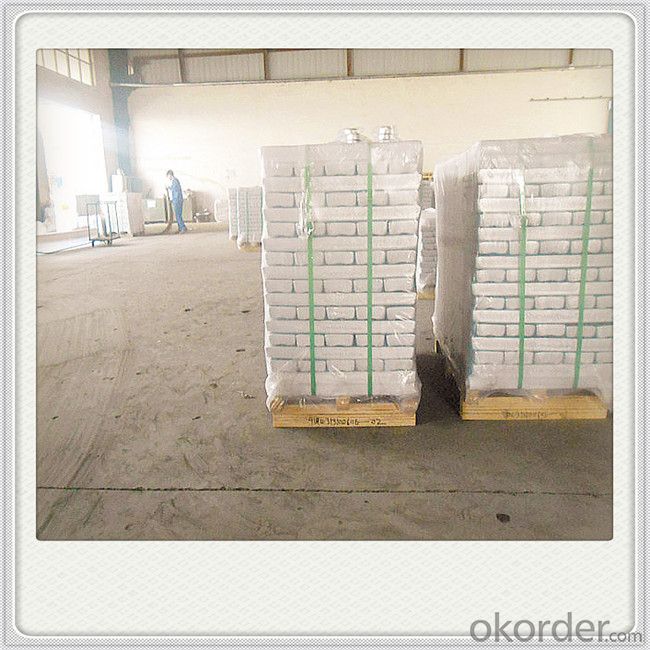





What is Magnesium Alloys?
Magnesium alloys are mixtures of magnesium with other metals (called an alloy), often aluminum, zinc, manganese, silicon, copper, rare earths and zirconium. Magnesium is the lightest structural metal. Magnesium alloys have a hexagonal lattice structure, which affects the fundamental properties of these alloys. Plastic deformation of the hexagonal lattice is more complicated than in cubic latticed metals like aluminium, copper and steel; therefore, magnesium alloys are typically used as cast alloys, but research of wrought alloys has been more extensive since 2003. Cast magnesium alloys are used for many components of modern automobiles, and magnesium block engines have been used in some high-performance vehicles; die-cast magnesium is also used for camera bodies and components in lenses.
Practically, all the commercial magnesium alloys manufactured in the United States contain aluminum (3 to 13 percent) and manganese (0.1 to 0.4 percent). Many also contain zinc (0.5 to 3 percent) and some are hardenable by heat treatment. All the alloys may be used for more than one product form, but alloys AZ63 and AZ92 are most used for sand castings, AZ91 for die castings, and AZ92 generally employed for permanent mold castings (while AZ63 and A10 are sometimes also used in the latter application as well). For forgings, AZ61 is most used, and here alloy M1 is employed where low strength is required and AZ80 for highest strength. For extrusions, a wide range of shapes, bars, and tubes are made from M1 alloy where low strength suffices or where welding to M1 castings is planned. Alloys AZ31, AZ61 and AZ80 are employed for extrusions in the order named, where increase in strength justifies their increased relative costs.
Magnox (alloy), whose name is an abbreviation for "magnesium non-oxidizing," is 99% magnesium and 1% aluminum, and is used in the cladding of fuel rods in magnox nuclear power reactors.
Magnesium alloys are referred to by short codes (defined in ASTM B275) which denote approximate chemical compositions by weight. For example, AS41 has 4% aluminum and 1% silicon; AZ81 is 7.5% aluminium and 0.7% zinc. If aluminium is present, a manganese component is almost always also present at about 0.2% by weight which serves improve grain structure; if aluminum and manganese are absent, zirconium is usually present at about 0.8% for this same purpose.
Any standard magnesium alloys are easily welded by gas or resistance-welding equipment, but cannot be cut with an oxygen torch. Magnesium alloys are not welded to other metals, because brittle inter-metallic compounds may form, or because the combination of metals may promote corrosion. Where two or more parts are welded together, their compositions must be the same. Soldering of magnesium alloys is feasible only for plugging surface defects in parts. The solders are even more corrosive than with aluminium, and the parts should never be required to withstand stress. Riveted joints in magnesium alloy structures usually employ aluminium or aluminium-magnesium alloy rivets. Magnesium rivets are not often used because they must be driven when hot. The rivet holes should be drilled, especially in heavy sheet and extruded sections, since punching tends to give a rough edge to the hole and to cause stress concentrations.
6.FAQ
We have organized several common questions for our clients,may help you sincerely:
①How about your company?
CNBM, The Fortune 500. A world class manufacturer & supplier of magnesium alloys ingots plates&sheets, magnesium alloy bars, Magnesium alloy slabs,magnesium alloy wires,magnesium alloy tubes and etc.. bases in China.
②How to guarantee the quality of the products?
We have established the international advanced quality management system,every link from raw material to final product we have strict quality test;
We would like to offer free samples for your inspect and check.
We have advanced manufactured equipments,such as hot rolling equipment. We resolutely put an end to unqualified products flowing into the market. At the same time, we will provide necessary follow-up service assurance.
③What is your main markets?
Our main markets are from Europ, America and Aisa. Such as Germany,Czech, Poland, England, Canada, Korea, Turkey etc.
- Q: Causes of high manganese content in magnesium ingot
- Potassium Permanganate heat decomposition of potassium manganate, manganese dioxide and oxygen, and the quality of solid oxygen generating surplus.
- Q: What is the black powder on the surface of magnesium ingot AM50A?
- The first is the alloy composition is different: AM50, AM60 is Mg-Al-Mn series, AZ91D is Mg-Al-Zn series.
- Q: What are the surface defects of magnesium alloy rolling?
- Because magnesium alloys are made of magnesium ingots, while magnesium ingots contain other elementsTherefore, magnesium alloys are generally used in die castingAluminum alloy is rolled only
- Q: What harm does magnesium alloy have to human body?
- The main element of magnesium aluminum alloy and AZ91D is magnesium. As long as it is not dust (flammable or explosive), direct contact with magnesium ingot is harmless
- Q: What are the generally feasible surface treatment methods for magnesium alloy die castings?
- Your question is difficult to answer, the general casting magnesium alloy surface treatment should be divided into surface coating treatment and surface treatment, although the two are related, but in the process and technology, but there is a big difference, its main features are not the same. Therefore, you must specify the purpose and function of your work before you can tell you the actual surface treatment.
- Q: Why the cost of ferrosilicon production will lead to a rebound in the price of magnesium ingot?
- 75# ferrosilicon in pidgeonmagnesiumprocess often used in high temperature smelting process of magnesium metal, will be replaced from CaO.MgO mg, each ton of magnesium will consume 1.2 tons of ferrosilicon, plays a big role in magnesium production.
- Q: The industrial application of magnesium and the main title and technical difficulty of producing magnesium products with magnesium chloride as raw material
- 1, unit investment is low.2, the production cost is low. As a result of magnesium ore, coal and other phasesThe prices of the raw materials are lower, the labor and management costs are not high, so the totalLower production costs.3, magnesium and related resources are rich. China is the richest country in magnesium resourcesOne of。 The total reserves of magnesite are 2 billion 700 million T, dolomite mine about 4000000000 T, and QinghaiThe potassium and magnesium salt and coastal brine magnesium reserves are very large.
- Q: What are the differences between aluminium magnesium alloy, aluminum alloy and plastic steel?
- In the fireworks production process plays a very important role in reducing agents, but also as a white light agent and lighting agentMagnesium alloy is magnesium ingots and aluminum ingots in protective gas melted into. For a long time about the structure of Al Mg alloy with two kinds of argument. One theory is that magnesium alloy is a simple physical mixture; another is magnesium alloy changes inside the crystal structure, is not a simple physical mixture.
- Q: Will the enterprises that produce sponge titanium use magnesium ingots?
- In the process of reduction, trace impurities in TiCl4 such as AlCl3, FeCl3, SiCl4 and VOCl3 are reduced by magnesium to form corresponding metals. These metals are all mixed with sponge titanium. Impurities such as potassium, calcium and sodium, which are mixed with magnesium, are also reducing agents. They reduce TiCl4 and produce the corresponding impurity chlorides respectively. Magnesium reduction process includes: TiCl4 liquid, gas and liquid gasification TiCl4 Mg diffusion of TiCl4 and Mg molecules adsorbed on the active center, in the active center of chemical reaction, nucleation, crystal growth, titanium MgCl2 desorption, diffusion MgCl2. The key step in this process is crystallization nucleation, accompanied by heterogeneous nucleation with chemical reactions.
- Q: What is magnesium aluminum alloy and what is its use?
- Magnesium alloy is magnesium ingots and aluminum ingots in protective gas melted into. For a long time about the structure of Al Mg alloy with two kinds of argument. One theory is that magnesium alloy is a simple physical mixture; another is magnesium alloy changes inside the crystal structure, is not a simple physical mixture.
Send your message to us
Magnesium Alloy Ingot Seller Good Quality Magnesium Metal Ingot
- Loading Port:
- Tianjin
- Payment Terms:
- TT OR LC
- Min Order Qty:
- 1 m.t.
- Supply Capability:
- 100000 m.t./month
OKorder Service Pledge
OKorder Financial Service
Similar products
Hot products
Hot Searches
Related keywords















